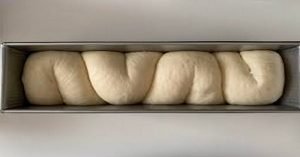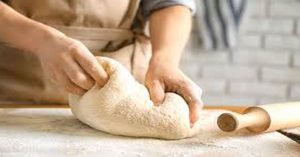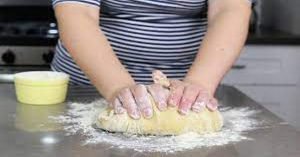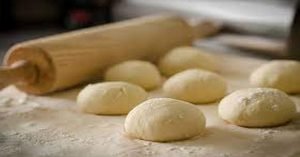Discover the Ripe Test

Discover the Ripe Test – FUNDAMENTAL FACTS – PART I
We use the “ripe test” to tell when the fermenting dough is ready for its first “punch down.” It is “ripe” when the gluten cell walls have stretched as far as they can go without collapsing. Do not let the dough get too light before this first “punch down.”

When the cell walls have stretched too far they will break. Then the carbon dioxide gas is no longer held in the gluten meshwork. This results in coarse, heavy bread. Once the dough goes beyond this “ripe” point, you cannot have really good bread.
Remember, that dough made in Utah from all-purpose white flour will usually increase in volume from two and one-half to three times before it is ready to show the “ripe” test.
Whole wheat dough or white dough made from soft wheat flour may be ready to punch down soon after it doubles in bulk. Occasionally you may find flour that makes dough that will not quite double in bulk before it is ready for the
first, punch.
Close observation of your first dough from each new bag of flour will tell you what to expect by way of volume increase from that particular supply.

If you use a container with straight sides, instead of a bowl with rounding sides, it is easier to tell when the dough has doubled or tripled in bulk. Put a clean plastic ruler between the dough and the side of the container.
Record the height of the flattened dough when it first goes in to rise. Assume that you have white dough in the crock, and its depth when it first went in was 3 inches. When the dough has doubled it will be 6 inches.
Start watching closely when the dough gets up to 7 inches. Make the first ripe test in the white dough before it reaches two and one-half times its original height.
If you have the whole wheat dough, start making the rip test before it is quite doubled in volume.

MAKE THE “RIPE TEST” THIS WAY
Push the first finger down to the second joint, quickly in and out of the dough.
The dough is ripe and ready for its punch down when:
1. The hole made by your finger stays in the dough without closing in.
2. The small creases show on the walls of the hole.
3. The bubble or blister appears near the edge of the hole. You may see several bubbles. If the hole closes in slightly, and the bubble does not appear, the dough is not “ripe.”
It needs a slightly longer fermentation period. If the whole mass of dough collapses quickly when your finger is pushed into it, the dough has gone beyond the point of being just “ripe.” It is too light.

PUNCH THE DOUGH DOWN
When the dough is “ripe,” it is ready for the first punch down. Punch your fist into the center of the dough. Then pull the edges in and fold them over into the center.
Punch the dough, all-round, a few times with the hand, then turn it over with the smooth side up. This smooth side will still have a thin film of fat from the bottom of the crock.
This punching down forces out some of the gas and breaks up the large gas pockets or bubbles. It also brings in a fresh supply of oxygen for the yeast cells to live on.
We use the “ripe test” only at the end of the first rising period. We time the others by the clock. You will find these time schedules with bread recipes.
Read more:
